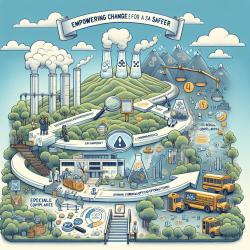Introduction
As a Special Education Director, ensuring the safety and well-being of students and staff is a top priority. The recent research article titled "Availability of Information about Airborne Hazardous Releases from Animal Feeding Operations" provides valuable insights that can be applied to enhance environmental safety in educational settings. This blog aims to help practitioners improve their skills by implementing the outcomes of this research and encouraging further exploration.
Understanding the Research
The study conducted by Smith et al. (2013) assesses the availability of information regarding airborne hazardous releases from Animal Feeding Operations (AFOs) under the Emergency Planning and Community Right-to-Know Act (EPCRA). Despite federal statutes requiring facilities to report hazardous releases, AFOs have been largely exempted, leading to limited availability of critical information.
Key Findings
The research revealed that only a small percentage of AFOs report hazardous releases, and the information available is often insufficient for assessing potential health risks. Key findings include:
- Only 15% of AFOs had at least one EPCRA report available.
- Information on the identity of substances released was available for just 15% of AFOs.
- Data on population density and sensitive populations within a one-mile radius were available for only 14% of AFOs.
Implementing Research Outcomes
Practitioners can leverage these findings to enhance safety protocols and ensure compliance with environmental regulations:
- Increase Awareness: Educate staff and parents about the potential risks associated with nearby AFOs and the importance of monitoring air quality.
- Advocate for Policy Changes: Work with local authorities to advocate for stricter reporting requirements for AFOs to ensure comprehensive data collection and public access.
- Enhance Monitoring: Collaborate with environmental agencies to establish air quality monitoring systems around schools to detect hazardous releases promptly.
Encouraging Further Research
While the study provides crucial insights, further research is needed to fully understand the impact of AFO emissions on public health. Practitioners are encouraged to:
- Conduct Local Studies: Partner with local universities or research institutions to conduct studies on the impact of AFO emissions on school environments.
- Share Findings: Disseminate research findings within educational and environmental networks to raise awareness and drive collective action.
Conclusion
By implementing the outcomes of this research, practitioners can play a pivotal role in ensuring safer educational environments. The journey towards improved environmental health requires collaboration, advocacy, and a commitment to ongoing research.
To read the original research paper, please follow this link: Availability of Information about Airborne Hazardous Releases from Animal Feeding Operations.










